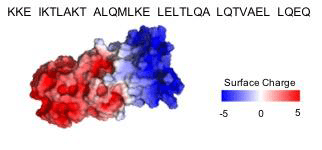Predictably control self-assembly into fibers on the mesoscale with functional capabilities of small molecule recognition.
Recent work in our lab rationally designed and computationally modeled Q, a coiled-coil mutant of the coiled-coil domain of the cartilage oligomeric matrix protein (COMPcc), that is capable of assembling into nanofibers and, upon binding to curcumin, into microfibers. Herein we proposed to use the Rosetta molecular modeling suite to computationally design coiled-coil fibers with optimal surface charge for supramolecular assembly and improved small molecule binding.

Rosetta modeling suite has been used to generate a novel Q protein construct with further optimized charge distribution. We propose that by generating a novel Q sequence in which approximately half of the surface is positively charged and half is negatively charged, we may improve the stability of the nanofibers. We have been working on creating the construct bearing the sequence (KKE IKTLAKT ALQMLKE LELTLQA LQTVAEL LQEQ), with improved surface charge for pentameric assembly (Figure 1). Due to issues with gene construction, we hope to have the sequence constructed and tested in the next cycle.
